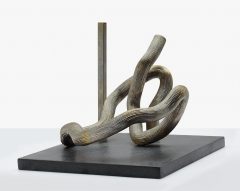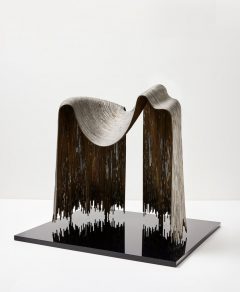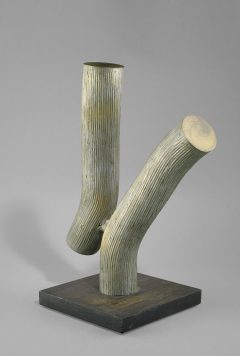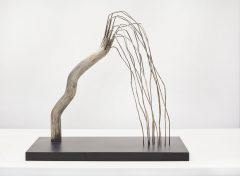Martin & Brigitte Matschinsky-Denninghoff
Station II
1987

Brass and tin on slate base
24.5 × 27 × 28 cm | 9 2/3 × 10 2/3 × 11 in
Signed with the initials and dated »87« underneath the base
Edition of Unique
Catalogue Raisonné by Költzsch/Schwarz 1992 no. 548
Collection North American Cerutti Corporation, Wisconsin (since 1989)
- Galerie Birgit Waller, Haus Lesmona, Bremen 1989
- Galerie Lopes, "Matschinsky-Denninghoff", Zürich 1989
- Galerie Kö 24, "Matschinsky-Denninghoff", Hannover 1988
- Georg W. Költzsch (Hg.), "Matschinsky-Denninghoff, Monographie und Werkverzeichnis der Skulpturen", Köln 1992, no. 548
In this way, we return the line to sculpture as a signpost and thus declare depth to be the only spatial form.1 Since the end of the 1950s, a newfound lightness in stylistic structure and expression can be observed in design, architecture and sculpture. Sculpture in particular underwent an innovation that can be traced back to the constructivism characterised by the brothers Naum Gabo and Antoine Pevsner, among others. As early as 1920, Gabo and Pevsner formulated ‘Das Realistische Manifest’, an important text for the generation of sculptors that immediately followed after the Second World War, which was intended to redefine the self-image of sculpture in five points. Space and time were declared to be the benchmarks of art and invoked as counterparts to the speed fetish in Futurism. The materiality of the substance should appear entirely in its original state without the addition of colour and exist in its surroundings. No other element could function better than the line to emphasise static forces, movement and rhythm without volume in three-dimensional space. 2
An artistic orientation towards the ‘Realist Manifesto’ and the new lightness of the 1950s cannot be denied in Martin and Brigitte Matschinsky-Denninghoff's sculptures. The dynamically resolved, sculptural bodies are always subject to a technical and formal-aesthetic regularity that has been consolidated over the years. They form their own spaces in which they unfold and with which they seem to enter into an indissoluble symbiosis.Since 1955, the year of the artist's marriage, the metal sculptures, composed of line, rod and tube, have opened up vivid vistas and moving views.Since the end of the 1960s, the sculptures no longer consist solely of vertical and/or horizontal rods, which become dynamic plates or organic tubes. The diagonal is also added as a line. In our work ‘Station II’, the vertical rod creates a contrast to emphasise the organic movement of the winding tube. Rich in complex ideas and artistic and intellectual influences, it was not until 1970 that the couple publicly formed the now well-known Matschinsky-Denninghoff duo, whose industrial style became their unmistakable signature. The ascending structure of the spatial graphics from bottom to top creates a dynamic that suggests movement and growth.With titles such as ‘Station II’, ‘Regenbaum II’, ‘Kleiner Herkules’ or ‘Botschaft’, the artist duo also intend to consciously steer the viewer's imagination, constantly tempting them towards representationalism and thus captivating them in an exciting exchange with the aesthetically visualised contradictions between openness and closedness, gravity and weightlessness.
Naum Gabo/Antoine Pevsner, ‘The Realist Manifesto’, Moscow 1920, pp. 203-204.
Cf. ibid.



